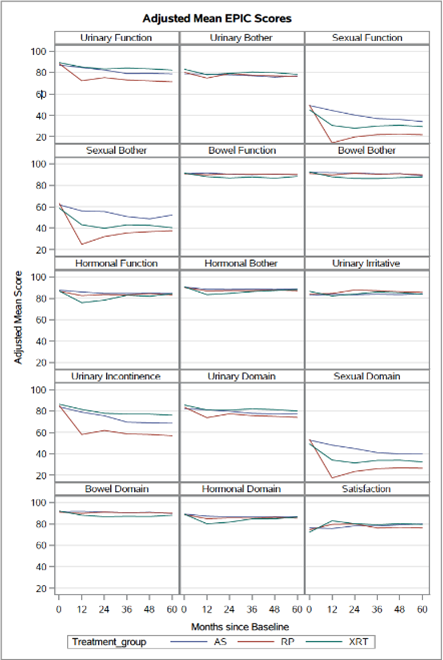Back
Poster, Podium & Video Sessions
Moderated Poster
MP43: Prostate Cancer: Localized: Active Surveillance
MP43-20: Long Term Health-Related Quality Of Life (HRQoL) Outcomes After Surgery, Radiotherapy, or Active Surveillance For Localized Prostate Cancer
Sunday, May 15, 2022
10:30 AM – 11:45 AM
Location: Room 222
Eyal Kord*, Nathan Jung, Seattle, WA, Jiji Jiang, Bethesda, MD, Natasza Posielski, On Ho, Seattle, WA, Sally Elsamanoudi, Gregory T. Chesnut, Bethesda, MD, Ryan Speir, Tacoma, WA, Sean Stroup, San diego, CA, John Musser, Honolulu, HI, Alexander Ernest, Houston, TX, Timothy Tausch, Bethesda, MD, John Paul Flores, Christopher Porter, Seattle, WA

Eyal Kord, MD,MPH
Virginia Mason Medical center
Poster Presenter(s)
Introduction: Treatment with curative intent for localized prostate cancer (PCa) is associated with a reduction in health-related quality of life (HRQoL). Current literature is limited by short-term follow up and homogenous populations. In this study we prospectively evaluated the 5-year HRQoL outcomes in men undergoing RP, EBRT or active surveillance (AS) in a racially diverse cohort.
Methods: The Center for Prostate Disease Research Multicenter Database was used to identify men with localized PCa diagnosed from 2007-2017. Expanded PCa Index Composite (EPIC) and 36 Item Short Form Health Survey (SF-36) were completed at baseline and yearly for 5 yrs. HRQoL outcomes were compared in RP, EBRT or AS using linear regression models, adjusting for baseline HRQoL, demographics, and clinical characteristics.
Results: Of the 1012 patients included in the study (mean age 61.6, 22.2% black), 252 (24.9%) underwent active surveillance (AS), 557 (55.0%) RP, and 203 (20.0%) EBRT. Low risk PCa was seen in 60.7% and intermediate risk in 39.3%. Mean follow up was 5.3 yrs.
Urinary function was worse after RP vs. AS or EBRT at all time points. Urinary function after EBRT and AS declined similarly until the first 2 and 3 years respectively, and then plateaued up to 5 years. Irritative symptoms were worst in AS between 2-5 yrs. RP showed the least Irritative symptoms and worse incontinence at all time points.
Sexual function and bother scores declined steeply at 1 yr. after RP. They subsequently improved until 5 yrs. RP sexual domain score was worse than AS and EBRT during yrs. 1-3 and equivalent to EBRT at years 4 and 5. AS was least affected in the sexual domains.
Bowel function and bother were worse for EBRT vs. AS and RP at all time points while hormonal domains were more affected at the first year. Although AS had the least impact on initial mental health scores, in the 3–5-year period, AS demonstrated the worst decline in all sub-domains.
Conclusions: RP results in worse urinary function and incontinence while irritative symptoms are more common in EBRT and AS. Sexual domain scores are least affected by AS while RP shows similar scores to EBRT at years 4-5. Bowel HRQoL is most impacted by EBRT. Long-term HRQoL changes after treatment are critical for patient counseling in localized PCa.
Source of Funding: USU-DoD-HJF Disclaimer: The contents of this publication are the sole responsibility of the author(s) and do not necessarily reflect the views, opinions or policies of Uniformed Services University of the Health Sciences (USUHS), the Henry M. Jackson Foundation for the Advancement of Military Medicine, Inc., the Department of Defense (DoD) or the Departments of the Army, Navy, or Air Force. Mention of trade names, commercial products, or organizations does not imply endorsement by the U.S. Government.

Methods: The Center for Prostate Disease Research Multicenter Database was used to identify men with localized PCa diagnosed from 2007-2017. Expanded PCa Index Composite (EPIC) and 36 Item Short Form Health Survey (SF-36) were completed at baseline and yearly for 5 yrs. HRQoL outcomes were compared in RP, EBRT or AS using linear regression models, adjusting for baseline HRQoL, demographics, and clinical characteristics.
Results: Of the 1012 patients included in the study (mean age 61.6, 22.2% black), 252 (24.9%) underwent active surveillance (AS), 557 (55.0%) RP, and 203 (20.0%) EBRT. Low risk PCa was seen in 60.7% and intermediate risk in 39.3%. Mean follow up was 5.3 yrs.
Urinary function was worse after RP vs. AS or EBRT at all time points. Urinary function after EBRT and AS declined similarly until the first 2 and 3 years respectively, and then plateaued up to 5 years. Irritative symptoms were worst in AS between 2-5 yrs. RP showed the least Irritative symptoms and worse incontinence at all time points.
Sexual function and bother scores declined steeply at 1 yr. after RP. They subsequently improved until 5 yrs. RP sexual domain score was worse than AS and EBRT during yrs. 1-3 and equivalent to EBRT at years 4 and 5. AS was least affected in the sexual domains.
Bowel function and bother were worse for EBRT vs. AS and RP at all time points while hormonal domains were more affected at the first year. Although AS had the least impact on initial mental health scores, in the 3–5-year period, AS demonstrated the worst decline in all sub-domains.
Conclusions: RP results in worse urinary function and incontinence while irritative symptoms are more common in EBRT and AS. Sexual domain scores are least affected by AS while RP shows similar scores to EBRT at years 4-5. Bowel HRQoL is most impacted by EBRT. Long-term HRQoL changes after treatment are critical for patient counseling in localized PCa.
Source of Funding: USU-DoD-HJF Disclaimer: The contents of this publication are the sole responsibility of the author(s) and do not necessarily reflect the views, opinions or policies of Uniformed Services University of the Health Sciences (USUHS), the Henry M. Jackson Foundation for the Advancement of Military Medicine, Inc., the Department of Defense (DoD) or the Departments of the Army, Navy, or Air Force. Mention of trade names, commercial products, or organizations does not imply endorsement by the U.S. Government.


.jpg)
.jpg)